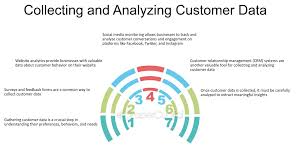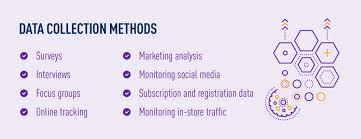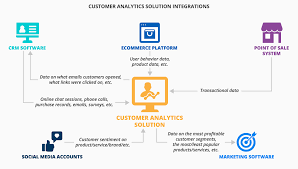Data is a crucial asset in today’s digital world. Specific customer data is a key in winning the competition and being successful in marketing, and businesses cannot get to make decisions based on assumptions and data-driven strategies.
Companies that effectively collect, analyze, and manage customer data can improve customer experiences, drive sales, and maintain a competitive edge in the market.
However, ethical and responsible data usage is crucial to gaining customer trust and ensuring long-term business success.

What is Customer Data?
Customer data refers to any information that businesses collect about their customers, including their personal information, behavioral patterns, purchasing history, and interactions with the company. This data is important for understanding customer preferences, improving services, personalizing marketing efforts, and making informed business decisions. Businesses collect customer data by various sources like as websites, mobile applications, surveys, social media, customer service interactions, and transaction records.
The primary goal of collecting customer data is to increase customer experience, optimize marketing strategies, and increase overall business efficiency. Customer data is classified into four main categories:
- Personal Data: It includes identifiable information such as name, email address, and home address, which supports businesses recognize and communicate with their customers.
- Transactional Data: Including purchase history, payment ways, order frequency, and subscription details, helping businesses understand buying behavior and preferences.
- Behavioral Data: Tracks customer activates, including website visits, product searches, and social media engagement, providing insights into customer interests and habits.
- Demographic Data: Includes details such as age, gender, location, income level, and profession, allowing businesses to segment their target audience and develop targeted marketing efforts.
Businesses utilize customer data for various purposes, including personalized marketing, customer relationship management (CRM), product development, and customer helps. By analyzing customer preferences and behavior, businesses can create tailored offers, recommend relevant products, and send personalized emails, enhancing customer engagement and brand loyalty.
Why Collect Customer Data?
Collecting customer data is essential for businesses as it supports in understanding customer behavior, improving services, and making strategic decisions. In today’s competitive market, data-driven insights authorize businesses to enhance customer experiences, optimize marketing efforts, and increase overall business efficiency.
Below are the key reasons why businesses collect customer data:
1.Personalization and Customer Experience
Customer data allows businesses to alter their products, services, and marketing messages to individual preferences. Through analyzing past purchases, browsing history, and interaction, companies can recommend relevant products and offer personalized discounts. This not only increases customer satisfaction but also build brand image.
2. Advertising and Targeted Marketing
Traditional advertising ways usually lead to wasted resources as they target s broad audience. Customer data authorizes companies to segment their audience based on demographics, interests, and buying behavior, ensuring that marketing reach the right customer at the right time. This leads to higher conversion rates and better return on investment (ROI).
3. Customer Retention and Loyalty Programs
By collection and analyzing customer data, businesses can identify loyal customers and create retention strategies such as rewards programs, exclusive discount, and special offers. Businesses use purchase history and customer feedback to develop loyalty programs that encourage repeat purchase. For instance, airlines and hotels offer reward points to frequent travelers, incentivizing them to continue using their services.
4. Improved Customer Support and Services
Access to customer data helps businesses provides better customer services by tracking past interaction, purchase history, and common issues. With detailed customer profiles, help teams can offer faster and more efficient solutions, improving customer satisfaction. Chatbots and AI-driven customer services platforms use data to gives instant responses and personalized help.
5. Business Growth and Decision-Making
Customer data helps companies identify trends, predict market demands, and develop new products or services. Data-driven decision making authorizes businesses to invest in areas that generate the most value, decreasing risks and improving operational efficiency.
6. Fraud Prevention and Risk Management
Businesses use customer data to detect fraudulent activates and prevent security breaches. By analyzing transaction patterns and user behavior, businesses can identify suspicious activates and take preventive measures. Financial institutions and e-commerce platforms use customer data to implement fraud detection systems, ensuring secure transactions.
7. Compliance and Regulatory Needs
In industries like finance, healthcare, and insurance, collecting customer data is necessary to comply with regulatory requirements. Businesses must maintain accurate records of customer transactions and personal details to ensure transparency and adhere to legal guidelines such as General Data Protection Regulation (GDPR) and CCPA (California Consumer Privacy Act).
In above all details, Customer data collection is important for businesses to stay competitive, enhance customer experiences. However, companies must also ensure ethical data handling, Privacy protection, and regulatory for build customer trust.

Ways on How to Collect Customer Data?
Customer data collection is a critical strategy for businesses to understand their target audience, improve services, and increase customer experiences. Through collecting data from different sources, businesses can personalize marketing efforts and making informed decisions.
Below are the most effective ways for collecting customer data, explained in detail:
Online Forms and Surveys
One of the most common methods for collecting customer data is by online forms and surveys.
- Businesses use these tools to directly ask customers for their personal information, preferences, and feedback.
- Surveys can be embedded on websites, sent via email, or shared on social media platforms.
- To enhance participation, businesses usually offer incentives like as discount, exclusive content.
This way permit businesses to gather structured data that can be analyzed to understand customer needs and for services improvement.
Website Tracking and Cookies
Businesses use website tracking and cookies to monitor user behavior and collect insights into how customers interact with their websites.
- Cookies support track data such as page visits, browsing patterns, session duration, and frequently viewed products.
- This data authorizes businesses to personalize the customer experience through recommending relevant products, improving website functionality, and retargeting customers with tailored advertisement.
However, companies must comply with privacy laws such as GDPR and CCPS through obtaining user consent before collecting data.
Social Media Monitoring
Social media platforms gives valuable insights into customer preferences, sentiments, and behaviors. Businesses collect data by tracking customer engagement by likes, comments, shares, and direct messages. Social media listing tools help businesses analyze brand mentions, customer opinions, and industry trends, allowing them to refine their marketing strategies and build engagement.
Customer Loyalty Programs
Loyalty programs are an effective way to collect customer data while encouraging repeat purchases. When customers sign up for these programs, they provides personal details such as contact information and shopping preferences.
Businesses track their purchase history, spending habits, and product preferences to permit personalized rewards, discounts, and targeted promotions. This method helps build long-term relationship with customers while collecting valuable insight into their buying behavior.
Email and Newsletter Sign-Ups
Businesses collect customer data by encouraging people to sign-up for email newsletters in exchange for exclusive offers, discount.
- Through gathering email addresses and demographic information, businesses can send targeted marketing campaigns, personalized product recommendations, and promotional content.
- Email marketing tools allows businesses to analyze open rates, customer engagement, and purchasing behavior, supporting in rebuild future email strategies.
Purchase History and Transactional Data
Tracking customer purchase history gives businesses with insights into their buying behavior, product preferences, and spending habits. Companies can predict future purchasing trends, optimize inventory management, and create targeted marketing efforts by analyzing transactional data.
Mobile Appa and User Behavior Tracking
Companies that have mobile applications can gather customer data by monitoring user behavior within the app. This includes tracking interactions with various features, search history, product views, and in-app purchases. With user consent, businesses use this data to increase app performance, send personalized notifications, and boost user experience. Analytics tools like Firebase and Mixpanel help businesses measure app engagement and identify customer preferences.
Customer Feedback and Online Reviews
Encouraging customers to leave reviews and feedback on platforms like Google, Trustpilot, and Yelp helps businesses collect firsthand insights into customer satisfaction.
- Reviews provide valuable information about product performance, service quality, and areas for improvement.
- Numerous businesses offer incentives such as discount coupons in exchange for detailed feedback. Monitoring and responding to reviews also strengthens customer relationships and creates brand credibility.
Collecting customer data by various methods helps businesses understand their target audience, make better services, and build personalized marketing strategies. From online surveys and website tracking to social media monitoring and purchase history monitoring, each way gives unique insights.
Four Main Categories of Customer Data to Collect
Businesses collect customer data in four main categories, each providing valuable insights to boost marketing, customer service, and general business strategies. Theses categories support businesses understand their audience, personalize experiences, and increase decision-making.
1. Personal Data
Personal data includes information that identifies a customer and helps businesses make personalized interactions. This category includes basic details such as name, age, gender, email address, phone number, home address, and date of birth. It also includes demographic data like income level, marital status, and education.Companies collect this information by account sign-ups, surveys, and online forms. Personal data is crucial for direct communication, targeted marketing, and customer segmentation.
2. Behavioral Data
Behavioral data tracks how customers interact with a businesses websites, mobile app, or other digital platforms. This includes browsing history, product searches, time spent on pages, purchase behavior, cart abandonment, ad engagement with advertisement. Businesses collect behavioral data using tools like cookies, website tracking, and analytics software.This data support businesses understand customer partiality, predict future behavior, and create individualize recommendations.
3. Transactional Data
Transactional DataTransactional data involves information related to a customers purchases and financial interactions with a business. It consists of purchase history, order value, payment ways, frequency of transactions, and return history. Companies collect transactional data through e-commerce platforms, point-of-sale systems, and invoicing records.
Monitoring this data helps businesses optimize pricing strategies, mange inventory, and create targeted loyalty programs.
4. Attitudinal Data
Attitudinal data focuses on customer opinions, emotions, and satisfaction levels. It is collected by surveys, feedback forms, product reviews, and social media comments. This data gives insights into customer partiality, brand perception, and areas for improvement. Companies can increase customer experience, build stronger relationships, and adjust their products or services based on customer expectations through analyzing attitudinal data.Above four main categories of customer personal data, behavioral, transactional data, attitudinal data businesses gain a deeper understanding of their customers. However, companies must ensure ethical data collection practices and comply with privacy regulations to maintain customer.

How to Analyze Customer Data
Analyzing customer data is important for businesses to make informed decisions, boost customer experiences, and develop personalized marketing strategies. Through effectively analyzing data, businesses can identify trends, predict customer behavior, and increase general business performance.
Here are the key steps involved in monitoring customer data:
1. Define Business Goals and Objectives
Before analyzing customer data, businesses must set clear objectives. Whether the goal is to boost customer retention, increase sales, enhance user experience, or identify market trends, defining objectives helps focus the analysis on actionable insights.2. Gather and Organize Data
Customer data is gathered from multiple sources such as websites, social media, customer surveys, email efforts, and purchase history. Businesses must ensure that all collected data is structured, categorized, and stored in a centralized database like a Customer Relationship Management (CRM) system for easy access and management.3. Clean and Prepare Data
Raw data usually contains errors, duplicates, and missing values. Data cleaning requires removing inconsistencies, correcting errors, and standardizing formats to ensure accuracy.Tools: like Excel, SQL, and Python libraries such as Pandas help clean preprocess large databases for analysis.
4. Segment the Data
Customer segmentation support categorize customers based on shared characteristics such as demographics, purchase behavior, preferences, and engagement levels. Segmentation allows businesses to alter marketing campaigns, personalize offers, and enhance customer experiences based on distinct customer groups.5. Identify Patterns and Trends
Using statistical and analytical tools, businesses can identify patterns and trends in customer behavior. For example, businesses can analyze purchase frequency, seasonal demand, and product preferences to predict future trends. Visualization tools like Tableau and Google Data Studio help present data insights in an easy-to-understand format.6. Apply Data Analytics Techniques
Several analytical techniques can be applied to customer data, including:Descriptive Analytics: Summarizes historical data to identify trends and past behavior.
Predictive Analytics: Uses machine learning and statistical models to forecast future customer behavior.
Prescriptive Analytics: Provides actionable recommendations based on insights to optimize decision-making.
Sentiment Analysis: Analyzes customer feedback, reviews, and social media mentions to determine customer emotions and satisfaction levels.
7. Measure Key Performance Indicators
Businesses track important measure track performance indicators such as customer lifetime value, customer retention rate, churn rate, conversion rate, and average order value.Monitoring these metrics helps evaluate business performance and identify areas for improvement.
8. Personalize Customer Experience
Using analyzed data, businesses can create personalized marketing efforts, product recommendations, and loyalty programs. AI-driven recommendation engines, like as those used by Amazon and Netflix, use customer behavior data to suggest relevant products and content.9. Ensure Data Security and Compliance
Data privacy laws like GDPR and CCPA require businesses to handle customer data responsibly. Ensuring data security, obtaining customer consent, and compiling with regulations helps build customer trust and prevent legal issues.Customer Data using to Drive Growth
Customer data is one of the most valuable assets for businesses, providing deep insights into customer behavior and trends. When used effectively, customer data supports businesses boost marketing strategies, increase customer experiences, improve sales, and drive long-term growth.
Below are key ways to businesses can leverage customer data to achieve sustainable success:
- Enhancing Marketing Strategies: Analyzing customer data helps businesses create targeted marketing campaigns. Businesses can design personalized promotion, retarget abandoned carts, and optimize ad placement by segmenting customers based on demographics, purchase history, and engagement levels.
- Optimizing Pricing Strategies: By analyzing transactional data and customer purchasing patterns, businesses can adjust pricing strategies to maximize revenue. Dynamic pricing models, where prices fluctuate based on demand, competitor pricing, and customer willingness to pay, help businesses stay competitive. Airlines, hotels, and e-commerce platforms frequently use customer data to optimize pricing and maximize profits.
- Increasing Customer Retention and Loyalty: Customer data helps businesses identify factors that drive customer loyalty. By analyzing purchase frequency, support interactions, and satisfaction scores, companies can implement loyalty programs, offer exclusive deals, and provide proactive support. Businesses use predictive analytics to anticipate churn and implement retention strategies, such as personalizes re-engagement emails or special discount for at-risk customers.
Conclusion
Collecting, analyzing, and managing customer data is essential for businesses to understand their audience, optimize marketing strategies, and drive growth. By using various data collection methods such as surveys, website analytics, CRM systems, and social media insights, businesses can gather valuable customer information.
Analyzing this data by segmentation, predictive analytics, and A/B testing helps boost personalization, customer engagement, and sales conversions. Proper data management, including secure storage, compliance with privacy laws, and regular updates, ensure data accuracy and builds customer trust. When implemented effectively, data-driven strategies enhance decision-making, improve customer experiences, and contribute to long-term business success.
FAQs
what are the benefits for data collecting customer data?
Collecting customer data provides numerous benefits for businesses, enabling them to enhance marketing strategies, boost customer experiences, and drive sales growth.
Through analyzing customer preference, behaviors, and purchase history, businesses can create personalized marketing campaigns that increase engagement and conversions.
Data-driven insights help companies optimize product offerings, predict market trends, and develop effective pricing strategies. Additionally, customer data allows businesses to improve customer service, build stronger relationships by loyalty programs, and enhance retention rates. Proper data collection also helps better decision-making, resource allocation, and competitive advantage while ensuring compliance with data privacy regulations to maintain customer trust.
what are the some common data collecting mistakes?
Is it legal to collect customer data?
Collecting customer data is legal, but businesses must adhere to data protection laws and regulations to ensure compliance. Laws such as the General Data Protection Regulation (GDPR) in the European Union, the California Consumer Privacy Act (CCPA) in the United States, and similar regulations globally require businesses to obtain explicit consent from customers, ensure data privacy, and provide transparency on how their data will be used.
Businesses must also allow customers to access, correct, or delete their data upon request. Failure to comply with these laws can results in legal penalties and damage to a company reputation.
Therefore, ethical and legal data collection practices are crucial for maintaining customer trues.





